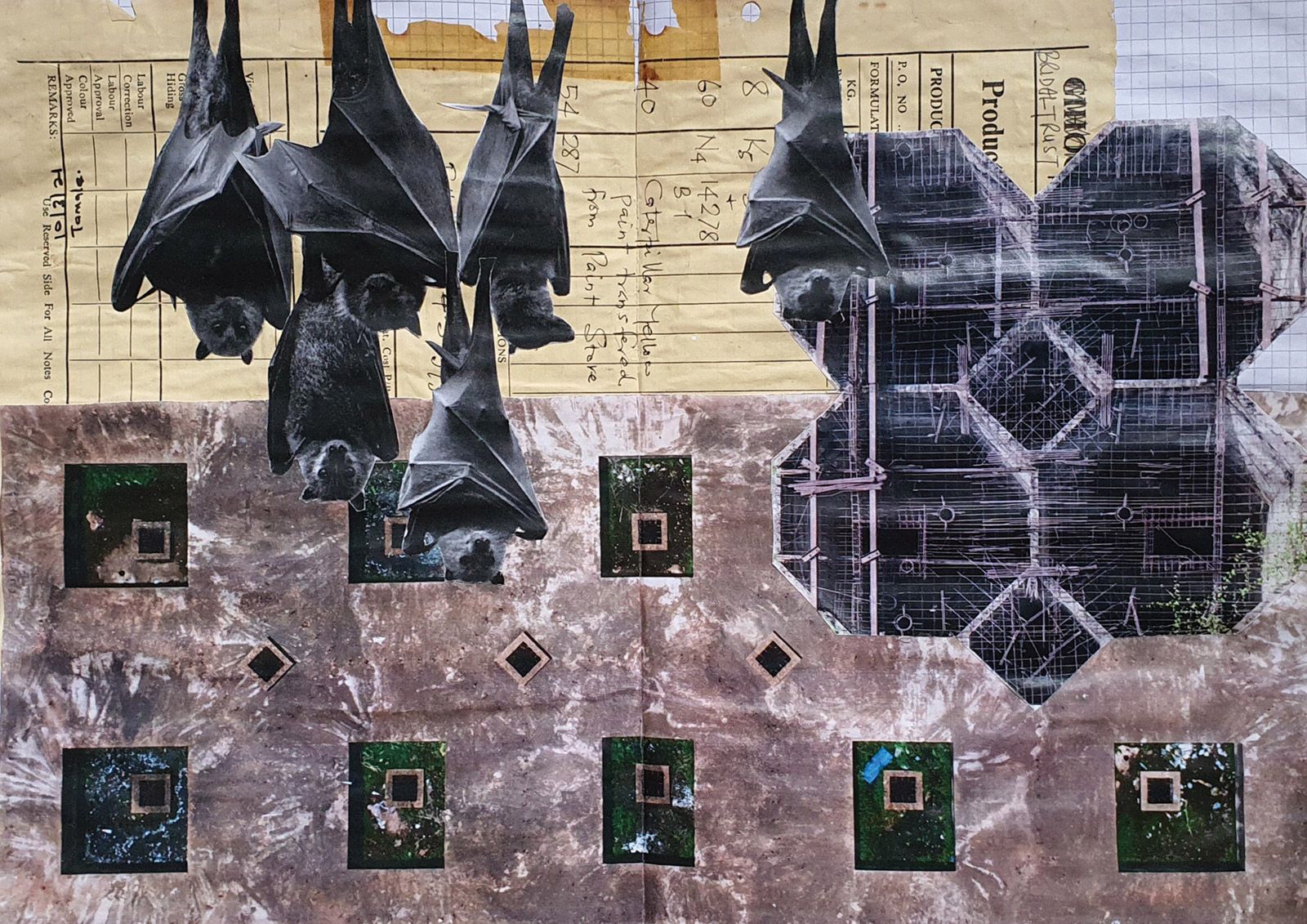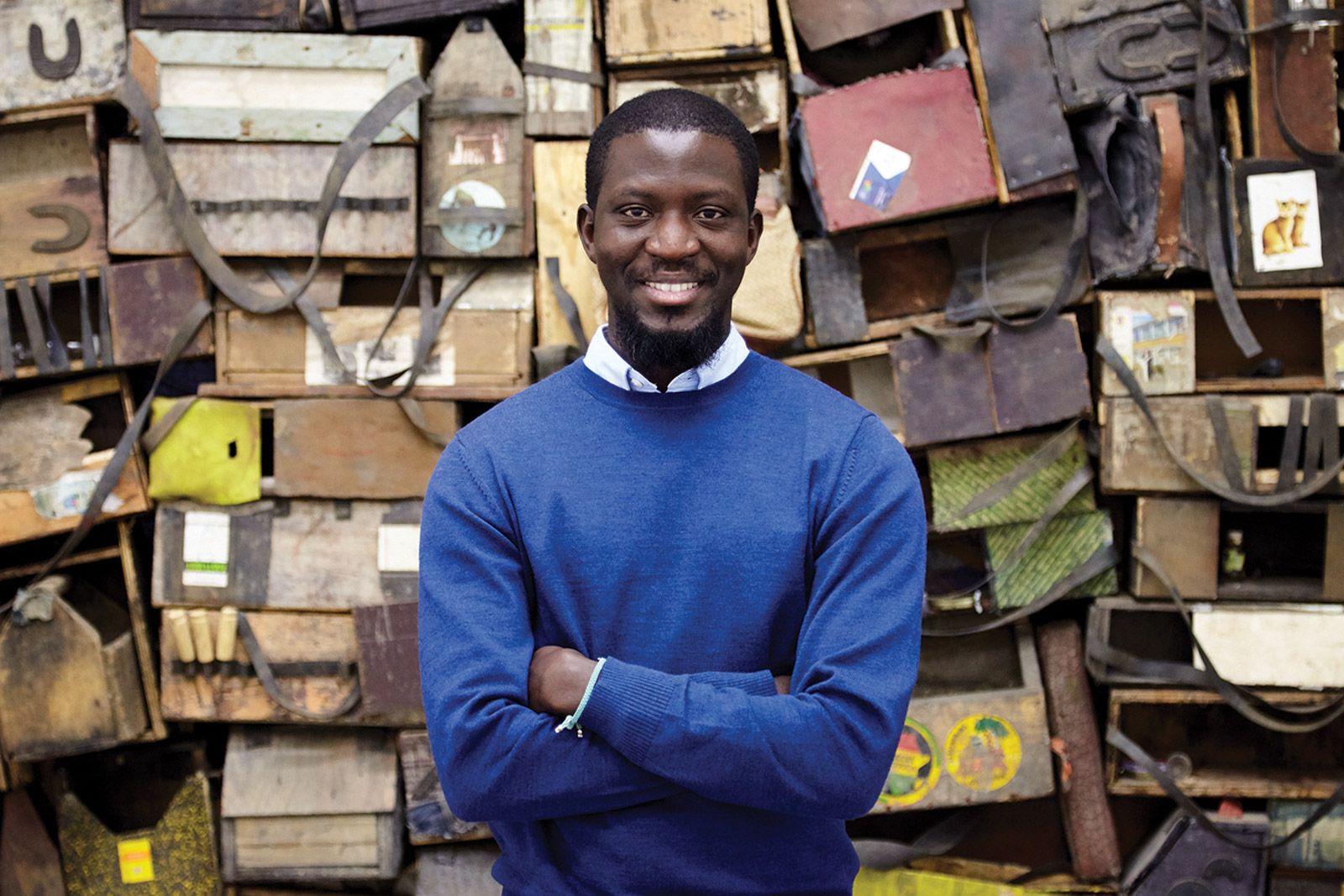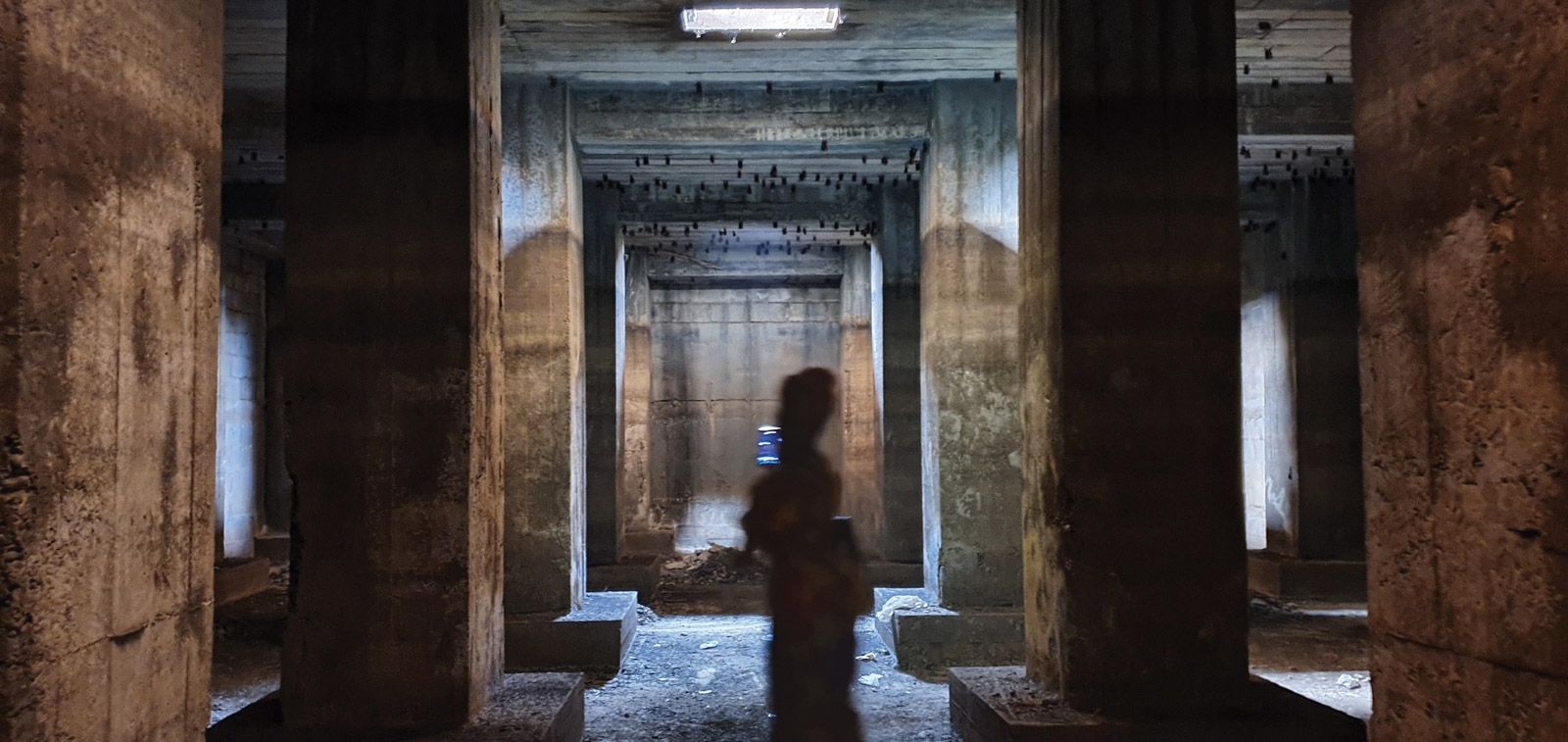
Ibrahim Mahama is best known for the massive tapestries of sewn-together jute sacks that he drapes over entire buildings. These have included theatres, luxury apartments and social housing projects in his native Ghana as well as two external walls of the Arsenale at the 56th Venice Biennale in 2015 and Kassel’s historic Torwache (guard buildings) for Documenta 14 in 2017. The jute sacks he uses are made in Asia and imported to Ghana to transport cocoa beans and rice to Europe, America and elsewhere. They are then often reused many times to carry feed, coal and charcoal around the country for domestic consumption before being finally repurposed by Mahama at the end of their working life to illustrate the complex trade networks of the global economy and post-independence Ghana.
Mahama also uses other culturally and historically freighted materials to explore themes of commodity, migration, globalisation and economic exchange. He has made installations from multiply-reused tarpaulins and wooden “shoemaker boxes”, used to contain tools to mend and polish shoes, and—in the inaugural Ghanaian pavilion at the Venice Biennale in 2019—created a pungent sculptural structure from the mesh cages used to smoke fish, which he filled with original archival material relating to Ghana’s history.

More recently, Mahama’s interest in architecture has extended from draping to acquiring buildings and using his art as a means to enact social change. In 2019 he founded the Savannah Centre for Contemporary Art (SCCA) in Tamale, the capital of the Northern Region of Ghana, which has expanded to become a hub for research and local engagement, with a programme of artist residencies and exhibitions that span SCCA and its sister institution, the nearby Red Clay, where Mahama also has a studio. Last year he acquired Nkrumah Volini, a huge disused building in Tamale—originally intended for food storage and distribution—which he is in the process of converting into a cultural centre.
The Art Newspaper: Can you tell us about Nkrumah Volini, which has provided much of the inspiration for the new work in the exhibition at White Cube in London?
Ibrahim Mahama: Yes, a major part of the exhibition is based on my encounter with these buildings from the 1960s, built after Ghana’s independence by our first president [Kwame] Nkrumah for the storing of food, grain, cocoa, nuts and things like that. Since 2015 I’ve been photographing these silo buildings and looking at the potential they hold within them. In the post-independence era there was a huge demand for African countries to be economically independent and to store food in large quantities until they reached the right value on the market. When Nkrumah was overthrown, none of these projects were continued and the buildings were abandoned and later privatised and sold. But the one in Tamale was one of the few that wasn’t. So when last year I heard the government was putting it up for sale I quickly mobilised some money from my work and was able to acquire it with the idea to transform it into a cultural institution.
What was it about this ruined, flooded, derelict silo building that appealed to you?
It’s as if the promise of economic freedom and the freedom of generations that were yet to come was somehow trapped within this space. So almost 60 years down the line, as an artist working now, and being interested in architecture, my question is: how do we take responsibility for these old spaces? How do we intervene within them? I took inspiration from the building’s name, Nkrumah Volini. In our language “volini” translates as “inside the hole” because people had been falsely led to believe that the building had been some kind of prison or detention centre. But although it has these negative connotations, when you deconstruct the word volini it can also mean an act of exhuming, an act of resurrection, an act of teleportation or of transformation. So, all along, this word volini, that was supposed to be so negative, also had buried in it an act of potential, and that’s where the White Cube show comes in: the idea that within the image of the apocalypse there is the possibility to see a way of transforming.
Hence the White Cube show being named after Lazarus, whom Jesus raised from the dead?
Yes, exactly.
Why have you used the image of bats in one of the White Cube installations?
A lot of reptiles, birds and animals had created a whole ecological system within the building, including a huge colony of bats. One of the most important decisions I had to make in the silo was not to get rid of the bats but to leave them in the building after we had excavated it. So one installation at White Cube has these abstract sculptural suggestions of the wings of bats made from steel and canvas tarpaulins. There are about 15 of them hanging from the ceiling. The canvas tarpaulins have been used for covering food, goods, cars and engine oil so they’re very dark and have oil on them—they are almost skin-like. So I’m also drawing a relationship between a global crisis and these ecological forms. I want the show to address ecological concerns, but at the same time also to push a certain aesthetic language.

Bats have had an especially bad rap in this time of Covid-19.
I think it’s very important, particularly in the era of the coronavirus, that the next generation who are coming up should understand that we have to learn to coexist with different species and to take new acts of responsibility for how we occupy spaces in the world. So if we discover bats living in a place, why do we have to get rid of them? These bats, they mostly just fly out at night and then they just come back and they settle. The idea has been to find ways in which we could allow them to multiply, and replicate and take over more of the space. We’ve antagonised animals and species for far too long, and humans have always been the cause of the extinction and extermination of animals, not the other way around.
Your other installation involves the reuse of 100 colonial-era school desks, each of which now contains an old sewing machine that every so often is made to clatter into life.
I like the history of schoolchildren writing on these desks in the same way people would also write on the old jute sacks. And I’m interested in the sewing machines at the point when they are dead and rusty and discarded, like the jute sacks in the other works I’ve done in the past. I collect them and rework them so that when you connect a motor, it activates the sound within the machine. When you hear a sewing machine running it means there is fabric in it, but this time around there isn’t any. They are empty and the sound is to resurrect the ghosts that are in the machines themselves. So this installation is a combination of people going to school to study versus people just learning a skill in order to be able to survive. I’m questioning these relations between the old and the new, the formal and informal, the global and local.
Like the jute sacks that you sewed together into huge tapestries to cover entire buildings, these new materials are being repurposed while at the same time carrying their histories.
The sewing machines connect directly to the jute sacks. I wanted something that could expand the language and aesthetics that I was working with. The jute sacks don’t make any sound. But when these machines are activated, they make this discreet sound and they are a bit repulsive in a way. And there’s also a relationship between the jute sacks and some of these machines, because sometimes people were forced to use some of these more heavy industrial machines to sew the sacks. There’s also a relationship and an antagonism between the jute sack and the silo because the jute sack is doing something that the silo should have done in a much better sense. So the sacks are like temporal vessels whereas the silos were supposed to be permanent containers. The jute sack can go on carrying other commodities until it ends up being used for charcoal and the material is stained and can no longer be used to transport anything. I’m interested in how when it’s at a point of death, this material can suddenly produce a new sense of language, of aesthetics. I use crisis and failure as the primary material in my work to be able to produce and develop new language and aesthetics. And this speaks to us about global conditions that are also related to my collaborators, the people I work with, the young migrants who construct my installations and sew these materials together.
With the purchase and conversion of Nkrumah Volini and more plans afoot to buy other buildings, it seems that your art is being used not only to express but also to enact social change.
These days I am more dedicated to the institutions that I am building in Tamale. We have three exhibition spaces: I’m doing it gradually, as and when I am able to get money from my work as an artist. So that’s most of the work that I do these days, I will only create objects when I have to produce an exhibition. Most of the work I produce takes the form of interactions and relations with young people. I’m more interested in democratising art and culture in its true form. I want to be the kind of an artist that changes the narrative of art, and also the narrative of how people live and interact. I’m now looking at old swimming pools that were built in the 1970s and other storage and factory spaces, which we could convert into small cultural institutions, and community centres where kids can go to learn about art, technology, agriculture, climate shift, whatever. The idea is to be able to redistribute contemporary art among the local population, and to reactivate life in a very different way. For me it’s important to remain in Ghana, to remain in the crisis, and to be able to produce from here. It’s almost like throwing seeds into the air, and then seeing them sprouting everywhere.
Biography
Born: 1987 Tamale, Ghana
Lives: Accra, Kumasi and Tamale, Ghana
Education: 2010-13 Kwame Nkrumah University of Science and Technology, Kumasi, BFA and MFA
Key Shows: 2020 22nd Biennale of Sydney; 2019 6th Lubumbashi Biennale, Democratic Republic of Congo; The Whitworth, Manchester; Fondazione Nicola Trussardi, Milan; Ghana Pavilion, 58th Venice Biennale; 2017 Documenta 14, Kassel and Athens; 2015 56th Venice Biennale; 2009 KNUST Museum, Kumasi
Represented by: White Cube, London; Apalazzo Gallery, Brescia
• Ibrahim Mahama: Lazarus, White Cube Bermondsey, London, 15 September-7 November
• Listen to our podcast interview with Ibrahim Mahama here
Source link : https://www.theartnewspaper.com/interview/ibrahim-mahama












